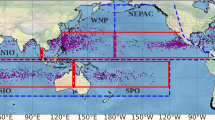Abstract
The genesis of tropical cyclones (TCs) over Indian seas comprising of Bay of Bengal (BoB) and Arabian Sea (AS) is highly seasonal with primary maximum in postmonsoon season (mid-September to December) and secondary maximum during premonsoon season (April and May). The present study is focused to demonstrate changes in genesis and intensity of TCs over Indian seas in warming environment. For this purpose, observational data of TCs, obtained from the India Meteorological Department (IMD), are analyzed. The sea surface temperature (SST), surface wind speed, and potential evaporation factor (PEF), obtained from the International Comprehensive Ocean Atmosphere Data Set (ICOADS), are also analyzed to examine the possible linkage with variations in TC activities over Indian seas. The study period has been divided into two epochs: past cooling period (PCP, period up to 1950) and current warming period (CWP, period after 1950) based on SST anomaly (became positive from 1950) over the BoB and AS. The study reveals that the number of severe cyclones (SCS) increases significantly (statistically significant at 99% confidence level) by about 41% during CWP though no such significant change is observed in cyclonic disturbances (CDs) and cyclones (CS) over Indian seas. It is also observed that the rate of dissipation of CS and SCS over Indian seas has been decreasing considerably by about 63 and 71%, respectively, during CWP. The analysis shows that the BoB contributes about 75% in each category of TCs and remaining 25% by the AS towards total of Indian seas. A detailed examination on genesis and intensity of TC over both the basins and the seasons illustrates that significant enhancement of SCS by about 65% during CWP is confined to the postmonsoon season of the BoB. Further, the BoB is sub-divided into northern, central, and southern sectors and the AS into western and eastern sectors based on genesis of TCs and SST gradient. Results show that in postmonsoon season during CWP, the number of SCS increases significantly by about 71% in southern BoB and 300% over western AS.










Similar content being viewed by others
References
De Angelis D (1976) World of tropical cyclones—North Indian Ocean. Mar Weather Log 20:191–194
Emanuel K (2005) Increasing destructiveness of tropical cyclones over the past 30 years. Nature 436:686–688
India Meteorological Department (1979) Tracks of storms and depressions in the Bay of Bengal and the Arabian Sea 1877–1970, report. Gov. of India, New Delhi
India Meteorological Department (2008) Tracks of cyclones and depressions in the Bay of Bengal and Arabian Sea 1891–2007, Electronic version, June 2008
IPCC (Intergovernmental Panel on Climate Change) (2007) Climate change 2007—the physical sciences basis. In: Solomon, Susan, Qin, Dahe, Manning, Martin (Eds.), Cambridge University Press
Knutson TR, Tuleya RE (2004) Impact of CO2-induced warming on simulated hurricane intensity and precipitation: sensitivity to choice of climate and convective parameterization. J Climate 17:3477–3495
Mohanty UC (1994) Tropical cyclones in Bay of Bengal and deterministic methods for prediction of their trajectories. Sadhana 19:567–582
Mohanty UC, Pattanayak S, Osuri KK (2010) Changes in frequency and intensity of tropical cyclones over Indian seas in a warming environment. Disaster Dev 4:53–77
Mooley DA (1980) Severe cyclonic storms in the Bay of Bengal, 1877–1977. Mon Weather Rev 108:1647–1655
Singh OP (2007) Long-term trends in the frequency of severe cyclones of Bay of Bengal: observations and simulations. Mausam 58(1):59–66
Singh OP, Ali Khan TM, Rahman MS (2000) Changes in the frequency of tropical cyclones over the North Indian Ocean. Meteorol Atmos Phys 75:11–20
Webster PJ, Holland GJ, Curry JA, Chang HR (2005) Changes in tropical cyclones number, duration and intensity in a warming environment. Science 309:1844–1846
World Meteorological Organization technical document (2008) Tropical cyclone operational plan for the Bay of Bengal and the Arabian Sea, Document No. WMO/TDNo. 84:1–1
Worley SJ, Woodruff SD, Reynolds RW, Lubker SJ, Lott N (2005) ICOADS Release 2.1 data and products. Int J Climatol 25:823–842
Acknowledgments
This work is supported by financial grant from Indian National Center for Ocean Information Services (INCOIS) and duly acknowledged. The authors also acknowledge with thanks to IMD for providing TCs observations including track and intensity. The authors also sincerely thank the NOAA/OAR/ESRL PSD, Boulder, Colorado, USA, for providing the ICOADS data through their web site at http://www.esrl.noaa.gov/psd/. We also thank the reviewer for his valuable comments to improve this manuscript.
Author information
Authors and Affiliations
Corresponding author
Rights and permissions
About this article
Cite this article
Mohanty, U.C., Osuri, K.K., Pattanayak, S. et al. An observational perspective on tropical cyclone activity over Indian seas in a warming environment. Nat Hazards 63, 1319–1335 (2012). https://doi.org/10.1007/s11069-011-9810-z
Received:
Accepted:
Published:
Issue Date:
DOI: https://doi.org/10.1007/s11069-011-9810-z




